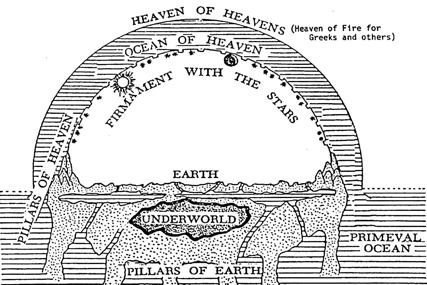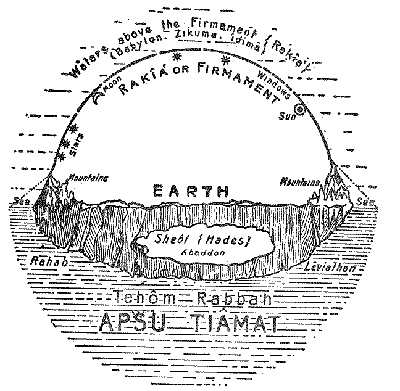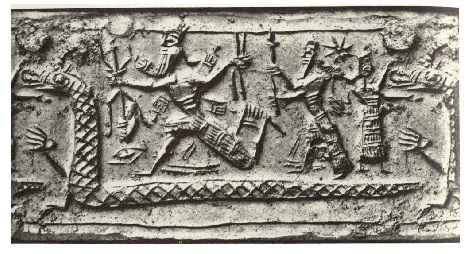It’s foolishness, I know, but let me dwell a little more on the “solid raqia” idea that I deliberately and sensibly avoided in the last post . The issue is, essentially, that the wise and good say that the Hebrews definitely believed in a solid raqia (or firmament) over the sky, that they definitely taught it in Genesis 1 and that there definitely isn’t such a thing surrounding the earth. Therefore their science was wrong and one must either say that Scripture is just untrustworthy, or that it doesn’t matter because the true message is not scientific (though that often turns out to mean “vaguely mythical and equally wrong”).
As it happens, I don’t think Genesis 1 is teaching science at all, as I’ve frequently stated. The idea of a cosmic temple predominates in the Genesis description, and though it ought to bear some phenomenological relationship to what we see around us, physical accuracy is not the name of the game. I’d even expect traces of their pre-scientific material ideas to creep into the text, though they would be irrelevant to its message. And I wouldn’t be looking for a close match between the processes described in Genesis 1 and the processes proposed by current science; more a match with how you might build a temple.
I’d go further and say that, if the author was pressed, he might very well have said that the temple imagery was the real truth, the physical nature of things being merely the superfical appearance – quite the opposite of our materialist mindset. But it’s really not so unfamiliar: the thinking Cartesian physicist nowadays would say that if a solid raqia did exist, it would be merely the sensory representation of what, behind the appearances, is scientifically an entirely different welter of quantum events, interacting charges, energy fields etc in non-localised relative space-time which, being only symbolic descriptions themselves, really should be replaced by a differential equation.
Another model of contemporary non-material views of reality would be to ask the Pope whether the Host and the Chalice are “really” bread and wine after consecration. He would no doubt explain transubstantiation in sophisticated Aristotelian-Thomistic terms of “substance” and “accidents”, but Aquinas only justified philosophically what Catholics started believing long before at a more instinctive level: the consecrated host “really” becomes the body of Christ, appearances (even scientific appearances) being secondary.
But in this post, once more, I don’t want to repeat the plea to try and get inside an ancient worldview that saw reality quite differently from ours, but to suggest at the more prosaic, physical, level that the “solid raqia” idea just doesn’t work in context. That might not matter if, as certainly seems the case with Babylonian cosmology, there was no self-consistent system and so internal contradiction and illogic is to be expected. But it’s the insistence by modern scholars that all the disparate clues in Scripture and ANE texts do add up to a consistent (scientifically mistaken) picture that falls apart on close examination.
Let me start with one detail of a picture I’ve used, and criticised, before as a modern false interpretation:
 You’ll see at the top, above the upper waters, “Heaven of heavens”. But this is actually a cop-out, for it’s not mentioned in Genesis 1, which clearly states that on Day 2 God makes the raqia and calls it “heavens” (shamayim), thus explaining how the heavens appeared in “the heavens and the earth” God created, in the first place. These (allegedly) solid heavens separate off the waters below from the waters above which, according to the scholars, would otherwise inundate the world, and they in turn need support from the “pillars of heaven” that are flown into their diagram (transformed without explanation into mountains) from Job.
You’ll see at the top, above the upper waters, “Heaven of heavens”. But this is actually a cop-out, for it’s not mentioned in Genesis 1, which clearly states that on Day 2 God makes the raqia and calls it “heavens” (shamayim), thus explaining how the heavens appeared in “the heavens and the earth” God created, in the first place. These (allegedly) solid heavens separate off the waters below from the waters above which, according to the scholars, would otherwise inundate the world, and they in turn need support from the “pillars of heaven” that are flown into their diagram (transformed without explanation into mountains) from Job.
For them to add a further, upper, layer of “heavens” separated from the raqia named “the heavens” by the massed waters above it is therefore quite arbitrary, and not in the text at all.
This closer look at the diagram also prompts us to ask why, if a solid raqia is necessary to stop the water falling down, the waters don’t just slide off it and drain away, taking the hydraulic load from the raqia and rain permanently from the earth. To that the only answer can be that a representation better fitting the text would be this:
 Here, the waters above the firmament, being as it were the “primordial ocean creation medium”, stretch into infinity (perhaps) in all directions, with the earth swimming along like the proverbial turtle. The waters are the highest point, and ergo must themselves be the highest heaven in which God dwells… for he certainly doesn’t live in the eggshell-like solid firmament. If this be the case, how come neither the Bible, nor any other ANE texts, describe the dwelling of God as being wet?
Here, the waters above the firmament, being as it were the “primordial ocean creation medium”, stretch into infinity (perhaps) in all directions, with the earth swimming along like the proverbial turtle. The waters are the highest point, and ergo must themselves be the highest heaven in which God dwells… for he certainly doesn’t live in the eggshell-like solid firmament. If this be the case, how come neither the Bible, nor any other ANE texts, describe the dwelling of God as being wet?
I’ve mentioned before the interesting episode of the elders of Israel eating and drinking in Yahweh’s presence (Ex 24). They climb Sinai to do so, and God’s pavement is duly represented as like blue lapiz lazuli, “clear as the heavens”. By conventional wisdom, they confirm the solid raqia’s existence by having dinner on its outer surface. But by conventional wisdom, too, they ought to have drowned in the waters above. Allegedly, rain comes by God’s opening doors in heaven (see below). So rather than simply walking up Sinai into God’s presence, the elders should have pushed open a trapdoor – with much the same detrimental effect as opening a hatch in a submarine on the sea bed. This would be so even if the gratuitously-added “heaven of heavens” lay above the cosmic ocean – they would have had to swim through it to reach God. Something doesn’t add up in the so-called “standard Hebrew cosmology”.
Something is not right in the corresponding “cosmological” interpretation of Genesis 1, either. I don’t know about you, but influenced by the standard model, and by a modern scientific idea of “space”, I begin my mental picture by imagining a formless, dark “deep” which is all there is. As an observer, I picture myself in a mini-sub, and God must, I suppose, work invisibly by remote control from outside creation. The spirit of God does not so much “hover” as tread water. But the real truth is that to the Hebrews, as to the Babylonians, the “primordial ocean” would not have looked like that, but would have been an ordinary-looking sea with a surface at the top, and the solid earth as its bed.
In Genesis 1.2, the earth already exists in a “formless and useless” manner, apparently covered in the water. The darkness is “over” the water. The wind, or spirit, of God also hovers or broods over these waters. John H Walton, not concerned with such issues in his NIV Application Commentary, still translates the end of v2 as “over the surface of the waters”, just as the KJV talks about “the face of the deep”.
The same imagery is true in the main source for “solid raqia” thinking in Babylonian myth, Enuma elish, where it’s pretty clear that the deities Tiamat (salt water) and Apsu (fresh water) are visualised as covering a world under an open “sky” rather than being infinite in all directions:
When in the height heaven was not named,
And the earth beneath did not yet bear a name,
And the primeval Apsu, who begat them,
And chaos, Tiamut, the mother of them both
Their waters were mingled together,
And no field was formed, no marsh was to be seen;
When of the gods none had been called into being,
And none bore a name, and no destinies were ordained;
Then were created the gods in the midst of heaven…
Then Apsu, the begetter of the great gods,
Cried unto Mummu, his minister, and said unto him:
“O Mummu, thou minister that rejoicest my spirit,
Come, unto Tiamut let us go!
So they went and before Tiamat they lay down,
They consulted on a plan with regard to the gods, their sons.
The topmost “primordial layer”, then, in both schemes, is not water but “dry space”. So when in Genesis God says “Let there be light”, I think the visual image intended is of the sea becoming visible under a blue sky, not of mysterious luminescence in the depths of an ocean, or even a blinding flash. The sea would be no deeper than seas usually are – the light penetrating even to its bed, the earth, perhaps.
To look at things another way, there is nothing uniquely “primordial” about the waters in the Genesis account: as soon as description begins in v 2, there is already an earth that is formless and void, a watery deep above it, and whatever space is above its surface, which is dark.
Scholar Nicholas Petersen, studying this matter, points out that each of the “separations” of the first three days of creation begins by God’s describing his work by a single general term, and then naming the result (ie revealing their function) with a recognisable name. So:
- He separates “light” from dark” and names them “day” and “night”.
- He splits the deep in two with “an expanse” (raqia) and names the expanse itself “heavens”.
- He causes a “gathering” of the lower waters into one place and names it “sea”.
- The resulting “dry” he names “land”.
Viewing it that way, one notices more critically that both the great lights of Day 4, and the birds of Day 5, actually move within the raqia, not below it. Even the Hebrews were astronomers enough to know that the sun and moon, and probably the planets, move relative to each other: the idea that they were engraved upon, or embedded in, a solid firmament, would not have worked for them (like the Greeks, they’d have had to invoke several such solid layers). The flight of birds, and their free transit between earth and sky, was even more apparent. The raqia, then, has every appearance of being (as it is often translated) the colloquial and real “sky”, rather than a supposedly solid shell keeping the ocean out of earth and, presumably, also causing rising damp in the higher regions of God’s dwelling.
But what about that water above the firmament? As far as I can see, the Hebrews had a very common, and pretty accurate, technical term for it: cloud. I mentioned earlier the elders of Israel meeting God on Mount Sinai in a dry heaven. The passage goes on to describe Moses’ and Joshua’s longer sojourn with God on Sinai, and says that cloud came down on the mountain for 6 days, and the voice of God called to Moses from within it.
 Have you ever been on a mountain in cloud? It’s wet. Not only that, but rain comes from cloud, as is readily observable from day to day up here on my Devonshire hill in the clouds, even were cloud not spelt out as the source of rain in Job 36.27-28:
Have you ever been on a mountain in cloud? It’s wet. Not only that, but rain comes from cloud, as is readily observable from day to day up here on my Devonshire hill in the clouds, even were cloud not spelt out as the source of rain in Job 36.27-28:
“He draws up the drops of water, which distill as rain to the streams;
the clouds pour down their moisture and abundant showers fall on mankind.”
Why, then, should one feel constrained to picture the waters above the firmament as a massive ocean above a solid shell, when clouds above an expansive sky fits the text better? Waters that visibly float in a sky (or on a hill, when you can see for yourself they’re unsupported) don’t need pillars or a roof to keep them up.
What is more Job 26, the very source of the “pillars of the heavens” which are fancifully interpreted as mountains supporting the raqia as it holds back the threatening upper waters, actually explains just three verses earlier where these waters actually are, staying miraculously up without any support:
He wraps up the waters in his clouds,
yet the clouds do not burst under their weight.
The waters above the firmament are specifically said to be wrapped up in clouds, which are, astonishingly, completely self-supporting.
Ah, but what about those “windows in heaven” God opened to cause the Flood in Gen 7? Well, the word does not mean “an opening” at all (still less a “floodgate” as in the NIV), but “something woven”, and is far more often used of the source of rain than in its other meaning of a lattice in a house. Does “woven” not call to mind a cotton-wool cloud (or a net to wrap up waters) in the sky more than a trapdoor in a ceiling? In Kings, the desire for God to “open the windows of heaven” is answered by the appearance of Elijah’s “cloud the size of a man’s hand,” which grows until it, without mirrors or trapdoors, produces a downpour. In any case, in Ps 78.23, “doors of heaven” is even poetically paralleled with “clouds” (not “sky” as in NIV): the doors are the clouds.
Another metaphor used for God’s sending rain, in Job, is “tipping over the water jars of heaven”. This too is poetically paralleled with “counting the clouds”. “Clouds” are therefore “the water jars of heaven”, as well as its “doors” and “windows”. What purpose, therefore, would an ocean above heaven serve? Or why have water jars if the primordial deep were to hand?
In summary, I don’t see that it’s legitimate to see the first stage of creation as a fathomless sea, either in Hebrew or Babylonian thinking. In both there is indeed a “chaotic” ocean, but in both creation cosmogonies its bed is an equally formless earth, and above its surface is a formless space.
In the biblical creation, the whole of that deep becomes either the waters below (seas, rivers, subterranean aquafers), or the clouds above “the heavens” (the functional name, remember, of the raqia) separating those two types of water. The heavens therefore must extend vertically from the land and seas of the earth, through the cloud layer (missing it completely on sunny days) until it reaches the higher reaches where even the birds can’t fly, and where no mountain pierces.
That region, the highest heaven, is the holy place where God is represented as dwelling – dry-shod! He may well be hidden in a cloud – as in Scripture he often is. But he’s not separated from his world by a solid defensive shell and an intractable aerial moat, as the modern scholars insist.



“As it happens, I don’t think Genesis 1 is teaching science at all, as I’ve frequently stated.”
I agree.
I think Genesis 1 is teaching miracles (e.g. something from nothing; life from dirt). And reality.
What do you think of the literal translation of heaven/sky in hebrew: “Shamayim.”
Which means “Water there”
Hi Hanan
I think it’s very helpful: The “raqia” is named “shamayim”, implying (assuming your Hebrew is on target, and why should I doubt it!) that there is water in the firmament. I’d already suggested that the most natural understanding of the waters above is “cloud”, and that there are a number of biblical texts that support that understanding.
If one is picky, one might say that the waters are above, not in the firmament. But the problem disappears if you take the raqia phenomenologically as “sky” – the clouds are over the top of it, but experience also shows they can encroach even down to ground level, in fog, and that the sky can also be full of rain.
The one thing your Hebrew doesn’t appear to support is the solid dome. Thanks for illumination!